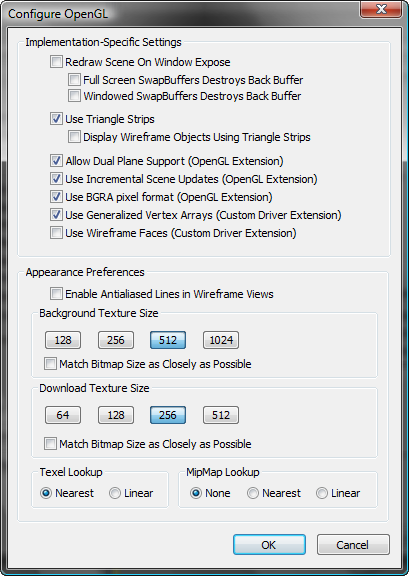The OpenGL display driver provides options that support hardware acceleration.

Implementation-Specific Settings group
Redraws the whole scene when a dialog over the viewports is moved, resulting in smoother dragging of dialogs such as the Material Editor or Track View. However, redrawing takes some time. Default=on.
If your 3ds Max display easily becomes messy or "corrupted," turn this option on and then redraw viewports by choosing Views  Redraw All Views (the default keyboard shortcut for this is the ` (accent grave) key, on the left side of the 1 key).
Redraw All Views (the default keyboard shortcut for this is the ` (accent grave) key, on the left side of the 1 key).
This option has two subordinate options. How you should set them depends on how the display card handles its back buffer, which is used for refreshing the screen. Turn on one or the other, as appropriate.
Uses the front/back plane system when redrawing the viewport. The selected object is manipulated in the front plane and is redrawn, while other objects remain on the back plane and are not redrawn. This default setting provides the fastest redraws under normal circumstances. If your assigned display driver doesn't support dual planes, this option is not available.
Turn off this setting to improve redraw speed if you are rotating the whole scene or moving a camera through the scene (usually situations in which the whole viewport needs to be redrawn anyway).
Redraws only those scene objects that have changed, or that intersect a region changed by another moving object. When off, the entire scene is redrawn for each new frame. Default=on.
If the display becomes messy or "corrupted" as a result of incremental updates, turn this option off and then redraw viewports
by choosing Views  Redraw All Views (the default keyboard shortcut for this is the ` [accent grave] key).
Redraw All Views (the default keyboard shortcut for this is the ` [accent grave] key).
When on, sends bitmaps using BGRA (blue-green-red-alpha) ordering for pixels. This is the default order for Windows. By default, OpenGL expects RGBA ordering. Because of this, under default conditions, loading textures or backgrounds requires the pixels to be reordered. OpenGL supports an extension that allows it to receive pixels in BGRA order. This means that bitmaps can be displayed directly, without reordering each pixel. Thus, assuming the OpenGL driver has efficient hardware support for BGRA pixels, turning on this option makes loading textures and background images much faster. Default=on.
When on, makes wireframe display accessible to hardware acceleration. Default=on.
This option is intended to allow display-card manufacturers to accelerate 3ds Max wireframe displays in a way that is specific to the underlying display hardware. Check with your display-card manufacturer to see if enabling this option will yield faster wireframe rendering with your display card.
Unlike the Software Display driver, which uses bitmaps to display viewport backgrounds directly, the OpenGL driver uses a texture-mapped background rectangle. This allows for smoother zooms and pans in orthographic views and can take less memory than the direct bitmap method. However, background bitmap resolution can be lost. Increase the resolution if you're using a maximized viewport to digitize. Default=512.
Specifies whether to use the nearest pixel or to linearly interpolate the pixel value from the four closest texels. Using the nearest pixel is faster, but using texels produces a higher-quality display. Default=Nearest.
Specifies whether to use one version of the texture map (None) or to interpolate between a pyramid of progressively smaller maps. With Nearest chosen, the texel lookup is done on the map level nearest the ideal one, and with Linear, the texel values from the two closest map levels are interpolated. Default=None.